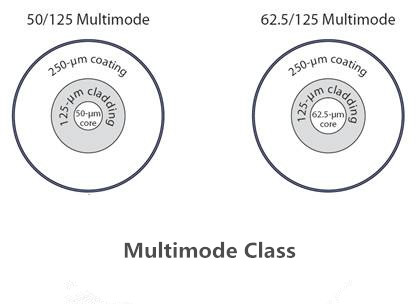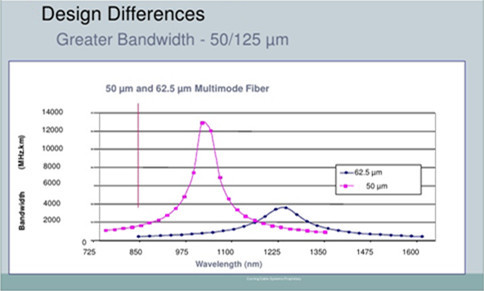How do I determine the type of fiber needed for my campus backbone? This is the question routinely asked by network designers. I must say, with many cabling options available in the market, it is a huge project to deploy a Gigabit Ethernet network—10GbE or 40/100GbE. As system engineers should not only decide which fiber type and the cabling infrastructure is perfect for their network, but the fiber counts. This article will briefly analyze the benefits of using laser-optimized 50µm multimode fiber in a Gigabit Ethernet application.
50µm Multimode Fibers Were Introduced
Before the advent of Gigabit Ethernet, choosing fiber type in a network design was quite easy. Standard 62.5µm multimode fiber (OM1) was used for any application up to 2000 m and network speeds up to 622 Mbps and single-mode fiber was used for anything else. But Gigabit and 10GbE changed these rules. Laser-optimized 50µm multimode fiber (like OM3 and OM4) was developed with increased bandwidth performance for 10GbE, and the fiber performance was included in the ANSI/TIA-568 Standard. Figure 1 provides a vivid impression on 50µm and 62.5µm multimode fiber.
Before the advent of Gigabit Ethernet, choosing fiber type in a network design was quite easy. Standard 62.5µm multimode fiber (OM1) was used for any application up to 2000 m and network speeds up to 622 Mbps and single-mode fiber was used for anything else. But Gigabit and 10GbE changed these rules. Laser-optimized 50µm multimode fiber (like OM3 and OM4) was developed with increased bandwidth performance for 10GbE, and the fiber performance was included in the ANSI/TIA-568 Standard. Figure 1 provides a vivid impression on 50µm and 62.5µm multimode fiber.

Why Consider 50 µm Over 62.5 µm?
The major difference between 50µm and 62.5µm multimode fiber is the bandwidth. 50µm fiber is specifically designed to produce higher bandwidth values than 62.5µm at 850 nm, which enables the fiber to be used with lower cost 850nm VCSEL transmitters. Standard 50µm fiber has three times the bandwidth of standard 62.5µm fiber in the short wavelength operating window while some of the never laser-based 50µm fiber designs have 10-20 times the bandwidth of standard 62.5µm fiber (see in Figure 2). The most commonly used 50µm fibers on the market for Gigabit Ethernet is OM3 and OM4.
The major difference between 50µm and 62.5µm multimode fiber is the bandwidth. 50µm fiber is specifically designed to produce higher bandwidth values than 62.5µm at 850 nm, which enables the fiber to be used with lower cost 850nm VCSEL transmitters. Standard 50µm fiber has three times the bandwidth of standard 62.5µm fiber in the short wavelength operating window while some of the never laser-based 50µm fiber designs have 10-20 times the bandwidth of standard 62.5µm fiber (see in Figure 2). The most commonly used 50µm fibers on the market for Gigabit Ethernet is OM3 and OM4.

OM3 and OM4 Fibers
OM3 and OM4 fibers are essential components to the success of 10G optical connectivity, which are optimized for laser-based 850nm operation and have a minimum 2000 MHz•km and 4700 MHz•km effective modal bandwidth, respectively. 10G operation is supported on OM3 to 300 m and OM4 to 550 m compared to 100 m with CAT 6A copper cable. The laser-optimized fibers provide a migration path for supporting even higher data rates such as 16G and 32G Fibre Channel and 40/100G Ethernet where CAT 6/6A has no migration beyond 10G. OM3/OM4 laser-optimized 50µm multimode fiber for 10G optical connectivity in data center enables better transmission distance and performance when comparing with OM1 and OM2 fibers. For example, GP-10GSFP-1S is compatible Dell Force10 10GBASE-SR SFP+ transceiver. It required an OM3 cable to realize the link length of 300m.
OM3 and OM4 fibers are essential components to the success of 10G optical connectivity, which are optimized for laser-based 850nm operation and have a minimum 2000 MHz•km and 4700 MHz•km effective modal bandwidth, respectively. 10G operation is supported on OM3 to 300 m and OM4 to 550 m compared to 100 m with CAT 6A copper cable. The laser-optimized fibers provide a migration path for supporting even higher data rates such as 16G and 32G Fibre Channel and 40/100G Ethernet where CAT 6/6A has no migration beyond 10G. OM3/OM4 laser-optimized 50µm multimode fiber for 10G optical connectivity in data center enables better transmission distance and performance when comparing with OM1 and OM2 fibers. For example, GP-10GSFP-1S is compatible Dell Force10 10GBASE-SR SFP+ transceiver. It required an OM3 cable to realize the link length of 300m.
As increased bandwidth requirements are called out in new installations, which have dictated a need to transition from cost-effective multimode systems to more costly single-mode systems to solve the problem of limited transmission distance in the existing infrastructure. However, compared with the expensive single-mode cabling, OM4 effectively provides an additional layer of performance that supports these applications at longer distances, thereby limiting the number of installations that truly require OS2 single-mode fiber. OM4 can even provide a minimum reach of 125m over multimode fiber within the 40 and 100GbE standards. For example, FTL410QE2C (compatible Finisar 40GBASE-SR4 QSFP+) covers a distance of 150m over OM4 cable.
Conclusion
When determining fiber types for a network application, a couple of key points should be drawn to help make the best decision. First, use the standards of each technology, do some analysis, understand the physical topology and the logical topology, then examine where you can save money. Last but not least, for distances less than 550 m, a laser-optimized multimode fiber may yield a price savings compared to a single-mode solution. Fiberstore provides a full range of multimode fibers including OM1, OM2, OM3 and OM4 multimode fibers. We offer these cables at a minimum price but with high quality. If you have any requirement of our products, please contact us directly.
When determining fiber types for a network application, a couple of key points should be drawn to help make the best decision. First, use the standards of each technology, do some analysis, understand the physical topology and the logical topology, then examine where you can save money. Last but not least, for distances less than 550 m, a laser-optimized multimode fiber may yield a price savings compared to a single-mode solution. Fiberstore provides a full range of multimode fibers including OM1, OM2, OM3 and OM4 multimode fibers. We offer these cables at a minimum price but with high quality. If you have any requirement of our products, please contact us directly.

Thank you for the information Fiber optic network cabling
ReplyDeleteThank you for the information structured cabling service
ReplyDelete